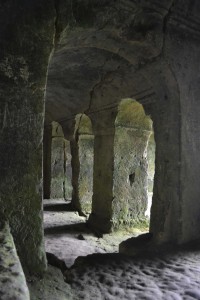This is only two hours from Istanbul, which is some people’s daily commute. In the lovely seaside town of Kıyıköy, on the bank of one of its two rivers, is the amazing Monastery of St Nicholas (41.634077,28.084456). It is cut into the rock, as are the churches in Cappadocia, but this rock is far more resistant. When one approaches, a set of arches appears in the cliff face. A man sits in a wooden chair, reading a newspaper. There is nobody else around. The man does not look up until addressed. He offers the use of a torch. Enquiries as to admission price are met with a laconic, ‘You may pay something if you like’. This article is about the bekçi (caretaker).
It is not like Cappadocia. The interior is cool and damp. The rock surfaces are covered with algae. The only graffiti consists of the algae being scratched away to form letters that do not seem to damage the rock. The tunnels are intricate and extensive. The churches are identifiably Byzantine but not made from masonry and carved blocks – it’s all hewn into the rock itself. An amazing place. It appears to have been built in the mid-sixth century, during the reign of Justinian. Apparently it resurfaced in the 1950s after floodwaters exposed the tunnels under the cliffs (Kassabova, 2017).
There was once a wooden porch outside that extended the uneven rock frontage to provide a sense of order. The nature of the rock means that entrance to the monastery is from the south. The main church is aligned in the customary east-west direction.It is a rather lovely three-naved building with the remains of a carved iconostasis and an impressive synthronon in the sanctuary.
A narthex leads along the western side of the church deep into the mountain wherein lies the ayazma. The narthex has some lovely carving and an impressive barrel-vaulted ceiling.
The ayazma is the real treasure. It is a four-column, domed, trefoil arrangement over a shallow (and cold) pool. Swallows nest on the walls and startle one as they dart past one’s ears in the dark.
The whole south-facing rock wall is hollow with monastic cells and tiny chapels. One can keep going eastward from the main entrance and continue finding bits of monastery. There is a cold spring with really nice water a few metres up on the right.
There is a lot of remaining Byzantine stuff around here. A big cave above the Kazandere River (41.619838,28.097556)has seen some Christian activity. Around the village of Balkaya (41.613196,27.96175) are some cave churches and another rock-cut monastery. The town of Vize 41.576263,27.767526) has everything from a Megalithic place of worship to a 6th century Byzantine church, inevitably called Ayasofya.
Atmaca, B. (2011) Aya Nikola Manastırı. Kıyıköy. Available online at: http://www.kiyikoy.gen.tr/kiyikoy-manastiri Accessed 25th Jan 2017
Civelik, E. (2016) Aya Nikola Manastırı. Kırklareli Kültür Varlıkları Envanteri. Available online at: http://www.kirklarelienvanteri.gov.tr/anitlar.php?id=80 Accessed 24th Jan 2017
Kassabova, K. (2017) Border: A Journey to the Edge of Europe. Granta. Partially available online at: https://books.google.com.tr/books/about/Border.html?id=owskDgAAQBAJ&redir_esc=y Retrieved 14 Oct 2017
Yeni Haber (2018) Aya Nikola Manastırı’nın 40 yıllık gönüllü bekçisi. Available online at: https://www.haberturk.com/aya-nikola-manastiri-nin-40-yillik-gonullu-bekcisi-2177380/3 Retrieved 8th Feb 2019

Categories: Uncategorized | 1 Comment »














June 30th, 2014 at 10:17 am
[…] Aya Nikola Manastırı (Kıyıköy) […]